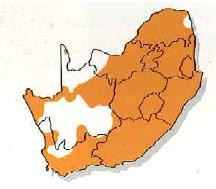Acacia karroo
| Acacia karroo |
|
|---|---|
Contents
General Plant Info
Family: Leguminosae (= Fabaceae)
Sub-family: Mimosoideae
Genus: Acacia Mill.
Species: Acacia Karroo
Common names: Sweet thorn (English); Soetdooring (Afrikaans); muBayamhondoro (Shona); Butema (Kalanga); Gaba (Kalanga); Mimosa thorn (English); Mooka (Tswana); Mookana (bush) (Tswana); isiNga (Ndebele); Orusu (Herero); muUnga (Shona); umuNga (Zulu)
Geographic distribution
Distribution: Acacia karroo is geographically the most wide spread species in southern Africa. The species is present in every country in the Southern African Development Community (SADC)except for Tanzania where it is replaced by the taxonomically similar Acacia seyal[1]
Habitat:
A highly tolerant species as illustrated by the broad geographic distribution. Grows adequately in most soil types and out of all the South African Acacia species it is the most tolerant to low temperatures [2]
Identification
Bark: Bark exhibits a colour range varying from dark brown to almost black. The texture is rough and flaky, with a reddish under-bark sometimes visible.[3] Bark is longitudinally fissured with smaller branches (<50mm) having a pale-grey to rust-reddish colour variation[1]
Spines: Young spines are mostly hairless. Older spines are also hairless and are white to greyish-white in colour, occasionally with small dark coloured spots[2]
Flowers: Flowers are deep or golden yellow pom-pom like[3]
Seed pods:
Alkaloid content
Extraction
Other uses
Acacia karroo Hayne [mubayamhondoro, muunga (Sh)] Root infusions are taken for convulsions and dizziness in Zimbabwe (Gelfand et al., 1985). In Zimbabwe, roots are also used for general body pains, and as aphrodisiacs.
Bark decoctions are taken as emetics for ailments believed to be caused by sorcery.

